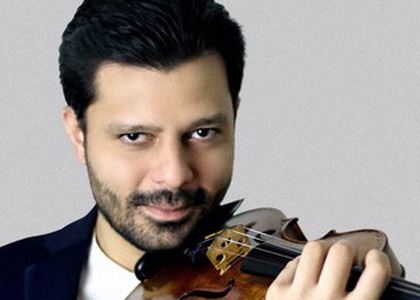> [Archived] Interviews

Interview with violinist Răzvan Stoica
This evening, starting at 7 pm, the "Henri Coandă" Hall of the Iași Palace of Culture is hosting the last recital of the national tour series, Baroque op. 1, proposed by the violinist Răzvan Stoica and the pianist Andreea Stoica. We are going to learn more details about the event's program from the violinist himself, who has been interviewed by our colleague, Ioana Țintea.
Răzvan Stoica, you find yourself in the middle of the ongoing National Tour, Baroque op 1. What were your thoughts upon setting off on this tour and what was the public's feedback about the musical program?
We started off with a great challenge in our minds, to interpret this repertoire inside a few churches in Romania, especially inside the cathedral of Alba-Iulia and the one from Sibiu, since the acoustic is very strong and there is also a strong reverb in these churches. Therefore, it was a challenge to stabilize the sound so that the public could be able to really understand the sounds coming from the violin and the harpsichord. The response coming back from Făgăraș, Sibiu and Alba-Iulia as well, was fantastic. We were actually glad to have sold-out halls. We had more than 500 people present at the Alba-Iulia concert. We are gladly waiting for the following concerts from the Baroque Tour.
What is the story behind this evening of recitals?
We wanted to choose a program that is lesspopular in Romania, with Baroque works, but also, to choose composers that are less popular, namely Veracini or Tartini, or some other arrangements by Alfred Schnittke, namely the Suite in the old style. We wanted to bring this sound, so specific to the Baroque period, together with the according timbres. I actually have two of my Stradivarius violin chords made from intestines, and we tried to use the harpsichord as a piano sound.
What is the message you wish to transmit byaddressing the Baroque opuses?
For us, our musical beginnings start with Bach. Everything he wrote for the violin, for the piano, the organ, and for the harpsichord is considered our bible, the musicians' bible. In a way, we are alsotrying to bring back this vibe of returning to the basics of music that has been lesspopular in the past few years.
The next tour stop, and also the evening's finale, will be taking place at the "Henri Coandă"Hall of the Iași Palace of Culture, where you will be interpreting, among others, Giuseppe Tartini'sG minor Sonata, The Devil's Trill. It is often talked about the difficulty of this sonata and it is considered by some violinists to be a piece of resistance. How do you perceive it?
It is, indeed, one of the most difficult works ever written for the violin. Many violonists would say that Paganini wrote in general more virtuously, or more difficultly, and yet, through this sonata, Tartini reached, let's say, the paroxysm of the left hand, because throughout 15 minutes, there are all the possible trills in G minor, D major, and A major. By which I mean, he takes them one by one. It is truly a difficult work, but it has a great plus. The sensitive partallows us, but also the accompaniment, which comes as an addition to the violin basis, to gain access to the more interpretative part.
When is the second opus of the tour going to take place?
The second opus of the tour will begin on the 1st of July, with a few concerts out in the open air, namely the one at the Cantacuzino domain, in Suceava, inside the court of the Putna Monastery, and also the one in Brașov.
Translated by Adelina-Maria Mănăilescu,
University of Bucharest, Faculty of Foreign Languages and Literatures, MTTLC, year I
Corrected by Silvia Petrescu














